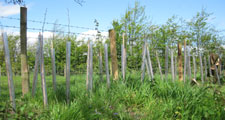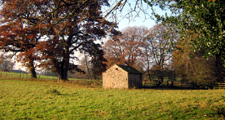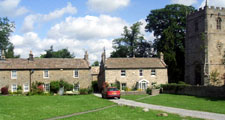Lower Dale
Land Management
Natural Features, Watercourses and Wetlands
- Protect river banks, gills & ravines from stock to encourage regeneration of semi-natural gill and riparian woodland.
Farmland
- Maintain and enhance semi-improved pastures by adopting appropriate stocking levels and avoiding improvements such as drainage, ploughing and reseeding. Limit the use of fertilisers and herbicides.
- Conserve species rich hay meadows – avoid ploughing and reseeding, herbicide and fertiliser applications. Time cutting and grazing regimes to promote flowering and seed setting.
- Restore former meadows and restore diversity to improved pastures where possible by reseeding or the use of hay crops from local meadows as a seed source.
Trees, Woodlands and Forestry
- Conserve, restore and extend gill, ravine, and riverside woods by fencing and excluding livestock to promote natural regeneration.
- Restore replanted ancient woodlands by felling and natural regeneration, or restocking with native species of local origins.
- Plant new native oak, ash and alder woodlands in gills and ravines, along river banks and streamsides, and oak-birch (sandstone) or ash (limestone) woodlands on steeper daleside bluffs. Avoid sites of existing nature conservation value.
- Increase the proportion of locally native species when restocking plantations.
- Protect and maintain existing hedgerow and field trees. Plant new hedgerow trees (Ash, Sessile Oak) and field trees (Ash, Sessile Oak, Sycamore) or tag saplings to replace the maturing stock.
Cultural Features
- Conserve and maintain traditional field barns and farm buildings.
- Protect and restore or consolidate old lime kilns – taking archaeological advice.
- Protect archaeological features including rigg & furrow, cultivation terraces and lynchets from damaging activities such as cultivation, overstocking, or poaching.
- Conserve and enhance old quarries by avoiding tipping and excluding livestock to promote natural regeneration. Maintain access to geological exposures.
Field Boundaries
- Protect, restore and maintain existing dry stone walls and hedgerows. Reinstate hedges and walls where they have been replaced by fences.
Development
Agricultural Buildings
- Site new farm buildings close to existing buildings where possible, and reflect their scale, character and materials.
- Reduce the impact of larger modern buildings by careful selection of colour, breaking up mass and planting screening belts of native species. Follow the North Pennines AONB Agricultural Building Design Guide.
Housing and Economic Development
- Protect and conserve the character of villages by ensuring that new development respects their scale, structure and vernacular character.
- Retain open green spaces within villages, and particularly village greens, old gardens and orchards, and tofts or garths.
Energy, Telecommunications and Infrastructure
- Avoid the siting of tall structures such as masts, pylons and wind turbines in the Lower Dale landscape generally.
- Where masts, pylons or domestic scale wind turbines are needed, site them close to existing buildings or woodland edges and avoid sensitive skylines. Where possible bury cables underground.
Minerals and Waste
- Avoid damage to sensitive natural landforms.
- Avoid extraction on prominent daleside slopes, or breaching local skylines with extraction areas or storage mounds.
- Restore quarry faces to naturalistic profiles using restoration blasting.
- Restore quarries to semi-natural woodland, grassland, wetland and bare rock habitats using natural regeneration where appropriate.
Tourism and Recreation
- Tourism and recreational development should be undertaken in such a way as to avoid any urbanising influence on the landscape. Existing buildings should be re-used where possible. New buildings should, where possible, reflect the scale, form, materials and vernacular detailing of traditional farm buildings in the area.
- Facilities like chalets and caravan parks should only be developed or extended where there is a high degree of year-round visual containment – either from the topography or robust woodland cover – so that they do not detract from the scenic quality of the area.
Further Information
- Description of Lower Dale character assessment
- Norh Pennines Strategy



